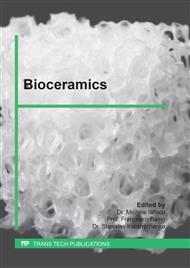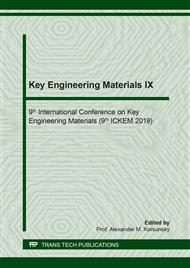[1]
A. R. Amini, C. T. Laurencin, and S. P. Nukavarapu, Bone Tissue Engineering: Recent Advances and Challenges,, Crit. Rev. Biomed. Eng., vol. 40, no. 5, p.363–408, (2012).
DOI: 10.1615/critrevbiomedeng.v40.i5.10
Google Scholar
[2]
J. M. Bouler, P. Pilet, O. Gauthier, and E. Verron, Biphasic calcium phosphate ceramics for bone reconstruction: A review of biological response,, Acta Biomater., vol. 53, p.1–12, (2017).
DOI: 10.1016/j.actbio.2017.01.076
Google Scholar
[3]
M. S. Kamath, S. S. S. J. Ahmed, M. Dhanasekaran, and S. W. Santosh, Bone Regeneration Based on Tissue Engineering Conceptions – A 21st Century Perspective,, Int. J. Nanomedicine, vol. 9, no. 1, p.183–95, (2014).
Google Scholar
[4]
G. Thanabalasundaram, N. Arumalla, H. D. Tailor, and W. S. Khan, Regulation of differentiation of mesenchymal stem cells into musculoskeletal cells.,, Curr. Stem Cell Res. Ther., vol. 7, no. 2, p.95–102, (2012).
DOI: 10.2174/157488812799218974
Google Scholar
[5]
E. Gómez-Barrena, P. Rosset, D. Lozano, J. Stanovici, C. Ermthaller, and F. Gerbhard, Bone fracture healing: Cell therapy in delayed unions and nonunions,, Bone, vol. 70, p.93–101, (2015).
DOI: 10.1016/j.bone.2014.07.033
Google Scholar
[6]
Y. Liu, J. Lim, and S. H. Teoh, Review: Development of clinically relevant scaffolds for vascularised bone tissue engineering,, Biotechnol. Adv., vol. 31, no. 5, p.688–705, (2013).
DOI: 10.1016/j.biotechadv.2012.10.003
Google Scholar
[7]
S. Tajbakhsh and F. Hajiali, A comprehensive study on the fabrication and properties of biocomposites of poly(lactic acid)/ceramics for bone tissue engineering,, Mater. Sci. Eng. C, vol. 70, p.897–912, (2016).
DOI: 10.1016/j.msec.2016.09.008
Google Scholar
[8]
G. Tetteh, A. S. Khan, R. M. Delaine-Smith, G. C. Reilly, and I. U. Rehman, Electrospun polyurethane/hydroxyapatite bioactive Scaffolds for bone tissue engineering: The role of solvent and hydroxyapatite particles,, J. Mech. Behav. Biomed. Mater., vol. 39, p.95–110, (2014).
DOI: 10.1016/j.jmbbm.2014.06.019
Google Scholar
[9]
H. R. Ramay and M. Zhang, Preparation of porous hydroxyapatite scaffolds by combination of the gel-casting and polymer sponge methods,, Biomaterials, vol. 24, no. 19, p.3293–3302, (2003).
DOI: 10.1016/s0142-9612(03)00171-6
Google Scholar
[10]
N. Monmaturapoj and C. Yatongchai, Influence of preparation method on hydroxyapatite porous scaffolds,, Bull. Mater. Sci., vol. 34, no. 7, p.1733–1737, (2011).
DOI: 10.1007/s12034-011-0384-x
Google Scholar
[11]
Š. Monika, Substituted hydroxyapatites for biomedical applications : A review Substituted hydroxyapatites for biomedical applications : A review,, Ceram. Int., vol. 41, no. 8, p.9203–9231, (2015).
DOI: 10.1016/j.ceramint.2015.03.316
Google Scholar
[12]
L. T. Bang, B. D. Long, and R. Othman, Carbonate Hydroxyapatite and Silicon-Substituted Carbonate Hydroxyapatite : Synthesis, Mechanical Properties , and Solubility Evaluations,, vol. 2014, (2014).
DOI: 10.1155/2014/969876
Google Scholar
[13]
W. H. G. Yang, X. F. Xi, J. F. Li, and K. Y. Cai, Comparison of crystal structure between carbonated hydroxyapatite and natural bone apatite with theoretical calculation,, Asian J. Chem., vol. 25, no. 7, p.3673–3678, (2013).
DOI: 10.14233/ajchem.2013.13709
Google Scholar
[14]
W. Suchanek, M. Yashima, M. Kakihana, and M. Yoshimura, Hydroxyapatite ceramics with selected sintering additives,, Biomaterials, vol. 18, no. 13, p.923–933, (1997).
DOI: 10.1016/s0142-9612(97)00019-7
Google Scholar
[15]
I. Ezekiel, S. R. Kasim, Yanny Marliana B.I., and Ahmad-Fauzi M.N, Nanoemulsion synthesis of carbonated hydroxyapatite nanopowders: Effect of variant CO32−/PO43−molar ratios on phase, morphology, and bioactivity,, Ceram. Int., vol. 44, no. 11, p.13082–13089, (2018).
DOI: 10.1016/j.ceramint.2018.04.128
Google Scholar
[16]
Yanny Marliana B.I., I. Wimpenny, O. Bretcanu, K. Dalgarno, and A. J. El Haj, Development of multisubstituted hydroxyapatite nanopowders as biomedical materials for bone tissue engineering applications,, J. Biomed. Mater. Res. - Part A, p.1–11, (2017).
DOI: 10.1002/jbm.a.36038
Google Scholar
[17]
Yanny Marliana B.I. and Ahmad-Fauzi M.N., Effect of a novel approach of sintering on physical properties of carbonated hydroxyapatite.,, J. Mater. Sci. Eng. B, vol. 1, no. 2, p.157–163, (2011).
Google Scholar
[18]
W. Y. Wong and Ahmad-Fauzi M.N., Synthesis and Sintering-wet Carbonation of Nano-sized Carbonated Hydroxyapatite,, Procedia Chem., vol. 19, p.98–105, (2016).
DOI: 10.1016/j.proche.2016.03.121
Google Scholar
[19]
A. B. H. Yoruc, A. Karakas, E. Ayas, and A. Koyun, Effect of precipitation method on properties of hydroxyapatite powders,, Acta Phys. Pol. A, vol. 123, no. 2, p.371–373, (2013).
DOI: 10.12693/aphyspola.123.371
Google Scholar
[20]
I. Uysal, F. Severcan, A. Tezcaner, and Z. Evis, Co-doping of hydroxyapatite with zinc and fluoride improves mechanical and biological properties of hydroxyapatite,, Prog. Nat. Sci. Mater. Int., vol. 24, no. 4, p.340–349, (2014).
DOI: 10.1016/j.pnsc.2014.06.004
Google Scholar
[21]
D. Liu, J. Zhuang, C. Shuai, and S. Peng, Mechanical properties' improvement of a tricalcium phosphate scaffold with poly-L-lactic acid in selective laser sintering,, Biofabrication, vol. 5, no. 2, (2013).
DOI: 10.1088/1758-5082/5/2/025005
Google Scholar
[22]
S. H. Min, H. H. Jin, H. Y. Park, I. M. Park, H. C. Park, and S. Y. Yoon, Preparation of Porous Hydroxyapatite Scaffolds for Bone Tissue Engineering,, Mater. Sci. Forum, vol. 510–511, p.754–757, (2006).
DOI: 10.4028/www.scientific.net/msf.510-511.754
Google Scholar



